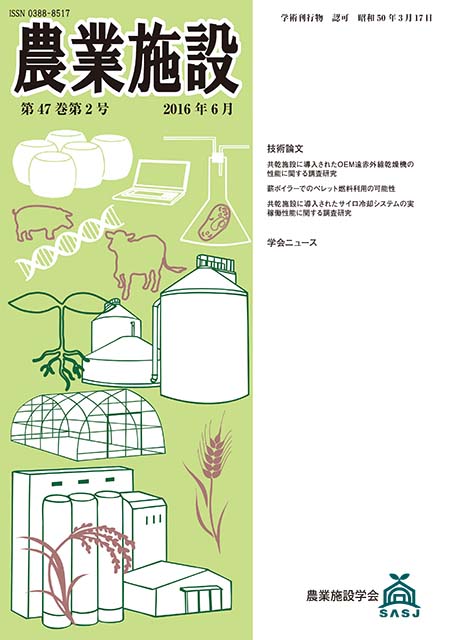All issues

Volume 47 (2016)
- Issue 4 Pages 146-
- Issue 3 Pages 95-
- Issue 2 Pages 59-
- Issue 1 Pages 1-
Volume 47, Issue 2
Vol. 47, No. 2 (Ser. No. 149)
Displaying 1-3 of 3 articles from this issue
- |<
- <
- 1
- >
- >|
-
Toru HIJIKATA, Hiroshi NAKATANI, Masakazu MATSUDA, Takaaki SATAKE2016Volume 47Issue 2 Pages 59-67
Published: 2016
Released on J-STAGE: September 07, 2023
JOURNAL OPEN ACCESSA new original equipment manufacturing (OEM) model dryer has been introduced for the operation of cooperative grain drying, processing, and storage facilities. Far-infrared rays are used as the heat source of this dryer. The use of far-infrared rays leads to a reduction in fuel consumption, and hence, the overall costs associated with the OEM product. As such, owners and operators will benefit from the reduced costs of replacing old systems in existing facilities and the construction of new facilities. Owing to its important function in the operation of grain storage facilities, we examined the basic performance of the new OEM far-infrared radiation dryer in actual use at half- and full-capacity operations. The results were consistent with design expectations, and are listed below. The processing capacity and drying rate were 17 t/h and ~0.6 %/h, respectively, at full-capacity operation, thereby confirming the prescribed operation rates. Furthermore, according to the standard drying methods, the drying temperature of the grains is <35 °C. Further, there was negligible increase in the percentage of cracked grains after drying, and there was no decrease in the quality of the grain. Moreover, the energy input (4.2–4.8 MJ/kg-H2O) requirement for the removal of water, is significantly lower than that (5.7 MJ/kg-H2O) required for older systems. These results confirm that the use of this dryer will lead to both reductions in energy consumption and operating costs.View full abstractDownload PDF (1469K) -
Genta KANAI, Hisashi KOWATA2016Volume 47Issue 2 Pages 68-75
Published: 2016
Released on J-STAGE: September 07, 2023
JOURNAL OPEN ACCESSTo assess the use of pellet fuels in wood boilers, we examined wood pellet and Giant Miscanthus (Miscanthus giganteus) pellet combustion in a wood boiler connected with a grain dryer. The lighting position, fuel adjuster board (FAB), and combustion control sheet (CCS) were examined for combustion process improvement. When pellets were burned in the boiler, fires were lit on the chimney side of the kiln, where the deep side of the kiln exhibited longer combustion duration time than at the air inlet side of the kiln. Unburned pellets were found accumulated in the kiln corner because of the poor air supply. The FAB was introduced to set pellets on the air inlet pipe, not in the kiln corner. The FAB improved the combustion duration time, the heat output, and the efficiency from fuel to the output. Pellets showed faster combustion than firewood because of their larger surface area. The CCS was intended to delay the pellet combustion by putting a heat insulating sheet on the fuel in the kiln to reduce exposure to air. Consequently, CCS had no effect on prolonging combustion duration, but it decreased the smoking time. Burning Giant Miscanthus pellets in the boiler was found to have longer smoking time than burning wood pellets. However, no major difficulty was observed compared to wood pellet combustion.View full abstractDownload PDF (1705K) -
Toru HIJIKATA, Souichi WADA, Hiroshi NAKATANI, Masakazu MATSUDA, Takaa ...2016Volume 47Issue 2 Pages 76-83
Published: 2016
Released on J-STAGE: September 07, 2023
JOURNAL OPEN ACCESSThe performance of a grain-cooling system for reducing the heat to which wheat and rice grains stored in silos are subjected through the exterior surface of the silo wall was evaluated. This system can be used when the grain temperature and the outside temperature are both high at the start of the storage process. Grain-cooling systems have seen numerous advances. However, few studies have investigated the effects of the operating conditions. We examined the basic performance of the grain-cooling system using an actual silo and obtained the following results. The cooling air introduced into the test silo used cooled the silo (storage capacity of 300 t) to 16–18 ℃ in 17–44 h, with the humidity being approximately 75 %. However, when examining the performance of the cooling system, we overlooked the process for cooling the dryer and stored 250 t of paddy grains in the test silo. The temperature of the stored paddy grains was initially approximately 36 ℃ but decreased to 20 ℃ in approximately 33 h. The results of these examinations confirm the silo-cooling effect of the system. However, it should be noted that the cooling time as well as the condensation of dew on the inner wall of the silo should also be taken into consideration during performance evaluation.View full abstractDownload PDF (1208K)
- |<
- <
- 1
- >
- >|